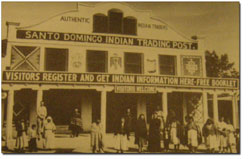| ||
A tale of two cultures
by Judith Reynolds Thunderstorms crackle over Shiprock as Jonathon Williams’ new film opens. It’s one of those classic scenes with a low horizon, blazing sky and a portent of doom. “Old West Trading Posts: 100 Years of Barter and Trade” is a nostalgic look at what may be a disappearing feature on the American landscape. And Williams’ film may have been made just in time. The number of trading posts has been dwindling as strip malls and Wal-Marts invade even the remotest corner of the country. The posts have been part of the Navajo Nation for more than a century, and that’s where Williams concentrates his eye. “Trading Posts” is a spin-off of Williams’ earlier film “Navajo Weavers: The Unchanging Artists of the Southwest.” Filmed in and around the Cameron Trading Post, the earlier documentary traces the story of Navajo weaving though archival photographs and contemporary footage, voice-over narration and real-time interviews. Williams employs the same techniques in “Trading Posts,” and he knows what he’s doing. Visually, the director sets the stage with spectacular shots of Shiprock, Monument Valley, and the high desert. A simple quote from an early trader, J.B. Moore, introduces the theme: buying and selling. What lies behind that simple fact of life is how it has been done in the West – awkwardly between two cultures and over time by building trust. In short, it’s a two-way street. Williams has wisely chosen to quote from archival sources and interview contemporary Native Americans as well as descendants of early traders. Among other things, Paul Begay, of the Dinnebito Trading Post, recalls tales his grandfather told him and explores how the two cultures confronted the language barrier; J.B. Tanner, a fifth-eneration trader, emphasizes the importance of trust; and Evelyn Jensen, of the Oljato Trading Post, talks about creating a family atmosphere. We also get a glimpse of the rich particulars: topics that could and couldn’t be discussed, recognition of conventions, respect for traditions, and the raw material of trading – packaged coffee, canned tomatoes, raw wool, finished rugs and beautiful blankets. Through it all, narrator Ray Parker tells the overarching story. Parker is a well known Durangoan. Last year, he was the subject of a documentary about his experiences as a prisoner of war during World War II. That film was aired at the 2007 Durango Independent Film Festival to considerable acclaim. Parker now brings his warm baritone voice and storytelling ability to this very different task. Director Williams has learned his craft well, and the film reflects the influence of America’s prince of documentaries: Ken Burns. An introductory section provides historical background as the camera slowly pans a large number of still photographs. Williams, the writer, begins at the end of the Civil War, and efficiently explores the government’s “Indian Problem,” Kit Carson’s torturous solutions, and key treaties. The film sets the stage by back grounding the American Indian experience of dislocation and loss and the white push westward. The traders, entrepreneurs all, saw an opportunity for bartering and ventured forth on what could only be called a chancy venture. “They needed each other,” Williams, 62, said in an interview last week. “Fort Defiance was too far away to get goods, so traders leased land and started a business.” Winning over skeptical, sometimes hostile “customers” was part of the bargain. Dropping just enough dates and statistics to tell the tale, Williams concentrates on the difficulties of the early period and the turmoil following the war. The narrator provides the overview, descendants emphasize the loneliness and isolation of the traders; Indian descendants talk about the slow process of building interdependence. A spare musical score provides an emotional underpinning. In his bag of tricks, Williams has professional music experience. He composed and arranged the score for “Trading Posts.” Again he’s taken a page from the Burns playbook – keep it simple, use only a few instruments, and evoke the period. The score alternates between piano, guitar, violin and, of course, flute. The music echoes the solitariness of the enterprise as well as the communal aspect, and it’s beautifully done. Bringing the film into the present, Williams explores what happened when the automobile came on the scene. He quickly cites the rise in tourism and the establishment of hospitality inns, the precursors to motels. As cars replaced the horse and wagon, change became rampant. Eventually, in our time, we’ve seen the arrival of the superstore. With some anticipation, I wanted to see how Williams wrapped things up. A rather sentimental conclusion made me uneasy. Without giving anything away, the ending will, or should, lead to discussion and differing opinions. •
|


